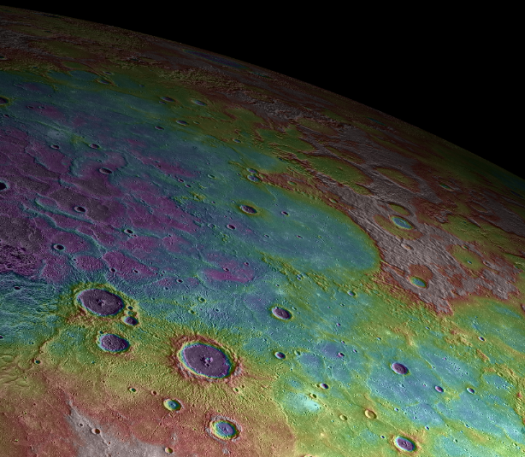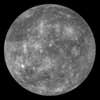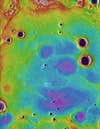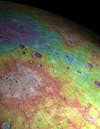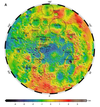NASA’s Messenger spacecraft entered orbit around Mercury one year ago this week, and the spacecraft has been hard at work. It has captured nearly 100,000 images, mapped Mercury’s gravity field, and taken sensitive altimetry measurements that are shedding light on the planet’s surface features like never before. This week, scientists on the Messenger mission published another round of new findings about the innermost planet, which turns out to be an altogether weirder world than we’d thought.
The planet’s crust is thicker in low latitudes and thinner at the poles, a distribution that suggests the planet could have a liquid outer core. Its core is also large relative to the planet, comprising 85 percent of the planet’s radius, much more than Earth. The findings suggest that a layer of liquid iron sulfide lies beneath Mercury’s crust, which would make the planet much different from the other terrestrial planets.
Mercury’s elevation changes are also much smaller than those of Mars or the moon, the new research found. The most prominent topographic feature is an uplift inside a major volcanic plain in the planet’s northern latitudes. Somehow this area lifted up after the plains formed.
There are also some weird features relating to Mercury’s largest impact basin, Caloris, actually one of the largest craters in the solar system. The floor of the 1,500-kilometer (932-mile)-wide crater is now higher than the rim, scientists found. This implies that Mercury underwent some major topographic changes after it formed — perhaps through tectonic forces. This is still up for debate, though, and an extended one-year mission could help settle it.
The two Mercury papers will be published online today in Science Express. Check out the photo gallery for some more interesting finds from the Messenger mission’s first year.
Mercury From Messenger
The planet Mercury as seen from the MESSENGER spacecraft, for MErcury Surface, Space Environment, GEochemistry, and Ranging. The mission has uncovered a wealth of new information about the nearest planet to the sun. Its core is relatively huge, for one thing — almost 85 percent of the planet’s radius. By contrast, Earth’s core is about half its radius.
Smooth Volcanic Plains
This vista shows ancient volcanic plains in the northern high latitudes of Mercury, captured by instruments onboard the MESSENGER spacecraft. These northern smooth plains comprise about 6 percent of the surface of Mercury and were created almost four billion years ago. The large circular features are impact craters from space rocks that impacted after the plains formed. The softer, more subdued circular areas are remnants of ancient craters that were later flooded by molten rock. Some of these features contain patterns of cracks, which could be related to to cooling and deformation of the plains. This image is a result of altimetry data from the MESSENGER Laser Altimeter superimposed on image data from the Mercury Dual Imaging System. Purple is low and white is high, spanning a range of about 1 kilometer (0.62 miles). The width of this photo spans about 250 km (155 mi).
Mercury’s High Latitudes
This perspective shows narrow, sinuous ridges on Mercury’s northern portions, rendered in reddish color, which suggests the planet’s volcanic plains were shaped by tectonic action. These are not quite mountain ranges — Mercury’s surface is less varied than even the moon — but it indicates past tectonic activity. The white region is a high plateau, which also indicates broad deformation of the volcanic plains after they formed. The circular features are impact craters. Again, purple is low and white is high, in this case spanning a range of roughly 2.3 km (1.4 mi). The chunk of Mercury seen here is about 1,200 km (745 mi). Each line of the map overlaid onto Mercury represents 5 degrees latitude and longitude.
Mercury North Pole
This image depicts Mercury’s topography from the north pole to 5 degrees south latitude. The planet has irregularly shaped lowlands at its high northern latitudes which are an average 2 kilometers (1.2 miles) deeper than surrounding terrain, researchers say. This can only be partly explained by impact craters — something else was at work to form these regions, perhaps migration of planetary mass related to its axial spin when it formed. Note Caloris Basin at top right, one of the largest impact craters in the solar system. With the exception of the largest ones, Mercury’s craters and interesting features are named for famous artists and composers.
Messenger and the Mercury Hollows
In this image you can see a strange “hollow” in the crater at the center. Hollows are present in several craters on Mercury, and scientists want to understand their relationship to pyroclastic vents on the planet, as well as how they formed. The Messenger mission marked its one-year anniversary in orbit around Mercury earlier this week. It has raised several new questions about the innermost planet, and NASA announced it would extend the orbiter’s mission for another year to help answer some of them. The nature of these hollows is one key question. Here are the main questions, from NASA: — What are the sources of surface volatiles on Mercury? — How late into Mercury’s history did volcanism persist? — How did Mercury’s long-wavelength topography change with time? — What is the origin of localized regions of enhanced exospheric density at Mercury? — How does the solar cycle affect Mercury’s exosphere and volatile transport? — What is the origin of Mercury’s energetic electrons?
Detail: Mercury North Latitudes
New observations from the Messenger spacecraft suggest a deep reservoir of high-density material exists within Mercury. Measurements show that Mercury must have sustained intense geophysical activity for most of its history, scientists say. Future observations will help answer some questions about how this material formed.
